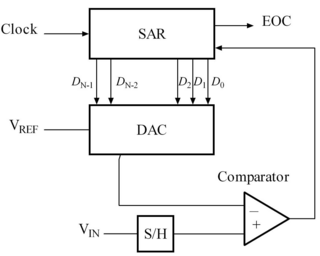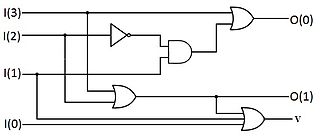
In computing and electronic systems, binary-coded decimal (BCD) is a class of binary encodings of decimal numbers where each digit is represented by a fixed number of bits, usually four or eight. Sometimes, special bit patterns are used for a sign or other indications.
In digital logic and computing, a counter is a device which stores the number of times a particular event or process has occurred, often in relationship to a clock. The most common type is a sequential digital logic circuit with an input line called the clock and multiple output lines. The values on the output lines represent a number in the binary or BCD number system. Each pulse applied to the clock input increments or decrements the number in the counter.
Elias code or Elias gamma code is a universal code encoding positive integers developed by Peter Elias. It is used most commonly when coding integers whose upper-bound cannot be determined beforehand.
Elias δ code or Elias delta code is a universal code encoding the positive integers developed by Peter Elias.
A ternary numeral system has three as its base. Analogous to a bit, a ternary digit is a trit. One trit is equivalent to log2 3 bits of information.

In electronics, a digital-to-analog converter is a system that converts a digital signal into an analog signal. An analog-to-digital converter (ADC) performs the reverse function.
Golomb coding is a lossless data compression method using a family of data compression codes invented by Solomon W. Golomb in the 1960s. Alphabets following a geometric distribution will have a Golomb code as an optimal prefix code, making Golomb coding highly suitable for situations in which the occurrence of small values in the input stream is significantly more likely than large values.
Unary coding, or the unary numeral system and also sometimes called thermometer code, is an entropy encoding that represents a natural number, n, with a code of length n + 1, usually n ones followed by a zero or with n − 1 ones followed by a zero. For example 5 is represented as 111110 or 11110. Some representations use n or n − 1 zeros followed by a one. The ones and zeros are interchangeable without loss of generality. Unary coding is both a prefix-free code and a self-synchronizing code.
Two's complement is the most common method of representing signed integers on computers, and more generally, fixed point binary values. Two's complement uses the binary digit with the greatest value as the sign to indicate whether the binary number is positive or negative; when the most significant bit is 1 the number is signed as negative and when the most significant bit is 0 the number is signed as positive. As a result, positive numbers are represented as themselves: 6 is 0110, zero is 0000, and -6 is 1010. Note that while the number of binary bits is fixed throughout a computation it is otherwise arbitrary.
In computing, fixed-point is a method of representing fractional (non-integer) numbers by storing a fixed number of digits of their fractional part. Dollar amounts, for example, are often stored with exactly two fractional digits, representing the cents. More generally, the term may refer to representing fractional values as integer multiples of some fixed small unit, e.g. a fractional amount of hours as an integer multiple of ten-minute intervals. Fixed-point number representation is often contrasted to the more complicated and computationally demanding floating-point representation.
In digital circuits and machine learning, a one-hot is a group of bits among which the legal combinations of values are only those with a single high (1) bit and all the others low (0). A similar implementation in which all bits are '1' except one '0' is sometimes called one-cold. In statistics, dummy variables represent a similar technique for representing categorical data.
XOR gate is a digital logic gate that gives a true output when the number of true inputs is odd. An XOR gate implements an exclusive or from mathematical logic; that is, a true output results if one, and only one, of the inputs to the gate is true. If both inputs are false (0/LOW) or both are true, a false output results. XOR represents the inequality function, i.e., the output is true if the inputs are not alike otherwise the output is false. A way to remember XOR is "must have one or the other but not both".
Densely packed decimal (DPD) is an efficient method for binary encoding decimal digits.
Non-standard positional numeral systems here designates numeral systems that may loosely be described as positional systems, but that do not entirely comply with the following description of standard positional systems:

A successive-approximation ADC is a type of analog-to-digital converter (ADC) that converts a continuous analog waveform into a discrete digital representation using a binary search through all possible quantization levels before finally converging upon a digital output for each conversion.
In computer science, the double dabble algorithm is used to convert binary numbers into binary-coded decimal (BCD) notation. It is also known as the shift-and-add-3 algorithm, and can be implemented using a small number of gates in computer hardware, but at the expense of high latency.
Single-precision floating-point format is a computer number format, usually occupying 32 bits in computer memory; it represents a wide dynamic range of numeric values by using a floating radix point.
In computing, decimal32 is a decimal floating-point computer numbering format that occupies 4 bytes (32 bits) in computer memory. It is intended for applications where it is necessary to emulate decimal rounding exactly, such as financial and tax computations. Like the binary16 format, it is intended for memory saving storage.

A priority encoder is a circuit or algorithm that compresses multiple binary inputs into a smaller number of outputs, similar to a simple encoder. The output of a priority encoder is the binary representation of the index of the most significant activated line. In contrast to the simple encoder, if two or more inputs to the priority encoder are active at the same time, the input having the highest priority will take precedence. It is an improvement on a simple encoder because it can handle all possible input combinations, but at the cost of extra logic.

In computing, an arithmetic logic unit (ALU) is a combinational digital circuit that performs arithmetic and bitwise operations on integer binary numbers. This is in contrast to a floating-point unit (FPU), which operates on floating point numbers. It is a fundamental building block of many types of computing circuits, including the central processing unit (CPU) of computers, FPUs, and graphics processing units (GPUs).





